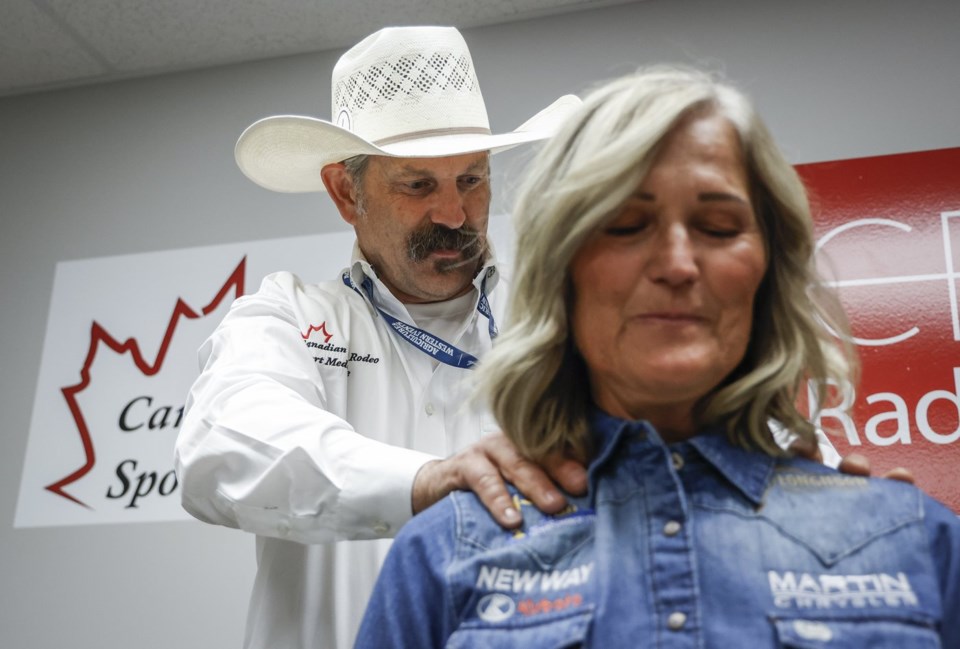CALGARY ŌĆö The action behind the bucking chutes can be as hectic as the rodeo infield at the Calgary Stampede.
The rodeo's medical clinic under the grandstand is a revolving door that starts whirling before the rodeo performance and is still spinning afterward.
Not only are medical practitioners there to treat riders hitting the dirt, their other mission is managing and treating the chronic injuries, aches and pains athletes bring with them to the Stampede.
"The Calgary Stampede is the only designated sport medicine and locker facility for rodeo athletes that was designed and then created," said chiropractor and Canadian Pro Rodeo Sports Medicine team president Blaine Bugg.
"The Americans and Brazilians are astonished they have access to a high-level functioning sport medicine team that does manual treatment, that they can work on bruises, bumps, strains and sprains and have success.
"We end up being pretty inundated during the Calgary Stampede."
The 10-day rodeo starting Friday offers $1.85 million in prize money to 270 contestants in bull riding, bareback, saddle bronc, steer wrestling, tie-down roping and barrel racing.
The field includes four-time world saddle bronc champion Zeke Thurston of Big Valley, Alta., and 2023 Calgary Stampede bull riding champion Jared Parsonage of Maple Creek, Alta.
The roughly 25 to 30 people on the medical staff are divided into three pods assigned to each of the three pools of rodeo contestants.
Each pod has a chiropractor, massage and athletic therapists and an emergency physician.
The athlete-medical dynamic in rodeo is completely different than that of a pro football or hockey team, whose medical staff has the power to determine if an athlete is healthy enough to step on the field or ice.
Riders and ropers, who are individual contractors paying entry fees, call their own shots. More often than not, they're getting on that horse or bull because they don't win prize money if they don't.
So the job of Bugg, who is a member of the Foundation for Chiropractic Progress, and his team is to help the athletes compete safely and to the best of their ability in Calgary, but also teach them what they can do when they leave the city to manage their injuries, aches and pains, and keep riding and roping.
"We don't stop talking. We're educating," Bugg said. "The strength of our program comes from educating the athlete, what their injury is, what they need to do next, how we can help them.
"We're going to lose them in a few days to somewhere else in North America. We have to have them fully prepared for how to treat themselves."
In the meantime in Calgary, athletic therapist Jocelyn Fredine is coming up with creative ways to tape or brace a limb to both protect it and allow mobility to compete.
"How strong can I make this, but still functional? You have to protect that body part with that in mind," Fredine said. "If I tape a bull rider's elbow too tight, so I'm trying to limit extension, but if I tape it too tight, it's going to pull his head down, and he's probably going to hit head-to-head with the bull."
Saddle bronc rider Layton Green of Meeting Creek, Alta., recalls his torn abdominal muscle treated in the clinic in 2017 and scoring well enough to finish second to Thurston in the Stampede.
"I dang sure think that wouldn't have happened without their help," Green said. "They taped me up through Calgary to where I couldn't really stretch the abdomen completely out, so it wouldn't get any worse."
Athletes often arrive with stiffness in their neck, hips, lower back and groin from driving to multiple rodeos in the span of a few days.
"This time of year guys have been probably going for 10 days in a row and then they're going up to Calgary, so they're pretty broken and bruised," said bull rider Jake Gardner of Fort St. John, sa╣·╝╩┤½├Į
"To be able to walk in there and see that team there, it feels good to get worked on and get feeling your best for one of the most important rodeos of the year essentially."
This time of year in rodeo is unofficially known as "Cowboy Christmas" because of the amount of money to be won in a condensed rodeo schedule in both sa╣·╝╩┤½├Į and the United States.
The Calgary Stampede falls in that window, so the rodeo's medical clinic is in high demand.
"Essentially, we're getting on a bucking horse every day this time of year so you get banged up and sore," Green said. "Seems like when you go in there, they can find some sort of way get you through that day and make you feel good enough that you can go out and compete at a level to win at, which is the main thing.
"They can give you a short-term fix that will get you by that day and point you in the right direction to get things back to where you need to be long-term, too. Hook you up with some different exercises."
Bugg's team provides medical and therapeutic services at 250 other rodeo performances during the season working out of a mobile trailer.
So dedicated space for multiple days in Calgary feels luxurious to Fredine, and the athletes who want to take advantage of it.
While bull riders can sustain catastrophic injuries, bareback riders are the most beat up, Fredine says.
Since bareback is first on the rodeo program in Calgary, those athletes are at the front of the parade into the clinic through a rodeo performance.
"The massage therapists and chiropractors are busy the entire time," Fredine said. "They have someone on their table every single second of that performance."
This report by The Canadian Press was first published July 4, 2024.
Donna Spencer, The Canadian Press



